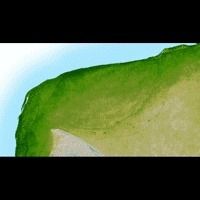|
An interesting news item from Reuters mentioned on in a
Story forum post about a mysterious pyramid in South American. Here's the full text
courtesy of Reuters news agency:
Space Dust to Unlock Mexican Pyramid Secrets
Tue Mar 16,10:44 AM ET
By Alistair Bell
TEOTIHUACAN, Mexico (Reuters) - Remnants of space dust that constantly showers
the world are helping unlock the secrets of a 2,000-year-old Mexican pyramid where the
rulers of a mysterious civilization may lie buried.
Deep under the huge Pyramid of the Sun north of Mexico
City, physicists are installing a device to detect muons,
sub-atomic particles left over when cosmic rays hit Earth.
The particles pass through solid objects, leaving tiny
traces which the detector will measure, like an X-ray
machine, in a search for burial chambers inside the
monolith.
Since there are fewer muons in an empty space than in
solid rock or earth, scientists will be able to spot any holes
inside the pyramid, a sacred site in the city of
Teotihuacan, which rose and fell around the same time
as ancient Rome.
"If we detect an area where there is less density than
expected, that gives us an indication that there is
probably a hole there," said Arturo Menchaca, head of
the National Autonomous University's physics institute.
Archeologists would then likely tunnel into the pyramid in
the hope of finding a burial chamber and solving the
riddle of who ruled Teotihuacan, also home to the smaller
Pyramid of the Moon and a huge temple to a fierce serpent god.
Housing 150,000 people at its apogee, the city's influence reached hundreds of miles to
modern day Guatemala but no one knows its true name or who its founders were.
The name Teotihuacan (The Place Where Men Become Gods) was given by awed Aztecs
who inhabited the area 700 years after the city was abandoned around 600 AD. The
Aztecs were stunned by the monumental buildings and precise city planning.
A Nobel prize winning scientist, Luis Alvarez of the University of California, Berkeley, used
muon technology in a scan of the Khephren pyramid in Egypt in the 1960s.
"Alvarez proved there were no hidden chambers in that pyramid and it is now in scientific
literature," said Menchaca, dressed in a hard hat in a cave directly under the Pyramid of
the Sun.
His team built the muon detector at a cost of $500,000 in the Mexican university's labs and
plan to install it in the coming months in the cave below the 206-feet (63-meter) high
pyramid.
Used for religious ceremonies several thousand years ago, the dark, humid cave is linked
to the outside by a narrow tunnel passable only by one person at a time.
A prototype detector set up in the cave has already found the first muons in the pyramid
overhead. The physicists hope to detect around 100 million of the particles in a year of
tests after the gadget proper is set up in a few months' time.
WAR ON TERROR
Muon technology could also be used by U.S. border agents in the war on terror, says the
Los Alamos National Laboratory in New Mexico.
"It's very credible. We have developed a muon detector system that can be used for
national security to detect nasty things in containers and trailers that we don't want to
enter the country," laboratory spokesman Kevin Roark said.
Muons, born when energy particles from space collide with the Earth's troposphere,
constantly bombard us but are harmless and almost unnoticeable.
When they pass by a detector, muons ionize gas trapped between two plates which in
turn causes an electric current that can be measured.
The method is more accurate, cheaper, and more versatile than X-rays but has only been
developed in recent decades due to advances in sub-atomic physics.
At Teotihuacan, archeologists hope the muon detector will be able to show whether the
pyramid, as well as being the city's state temple, is the last resting place for a king, or
perhaps several.
Archeologist Linda Manzanilla, Mexico's leading expert on the site, reckons the city in
its early days may have been run by a coalition of four rulers, and not a single king like
the Maya or Aztec civilizations in ancient Mexico.
"It is likely that those who started the four-way system, the first four, are the ones who
would be inside the Pyramid of the Sun," she said.
The number four is a constant theme in the city, split into four different residential zones.
A vessel from Teotihuacan found elsewhere shows four figures who appear to be
co-rulers around a god of thunder, Teotihuacan's state deity.
"Teotihuacan is up there with Rome, one of the biggest pre-industrial cities in the world.
Constantinople is also maybe there but no Chinese city was of this magnitude. Egypt
didn't even have cities," Manzanilla said.
The Pyramid of the Sun was probably a fertility symbol built around 80 AD and shaped
like a mountain to counteract the evil influence of two nearby volcanoes known to have
gone through unusually violent eruptions at the time.
Nobody knows what ethnic roots the city's inhabitants had or what language they spoke
as they left no written records.
"I wish they would invent a time tunnel and we can hear them speak. What ethnic group
did they represent?" said Manzanilla.
|
